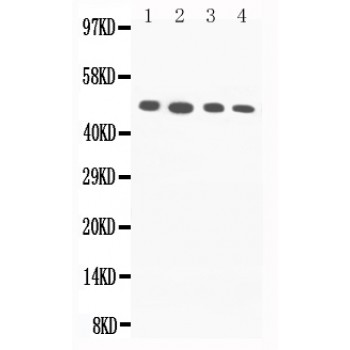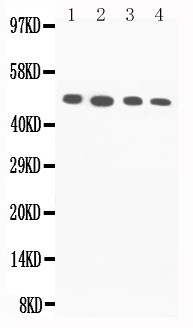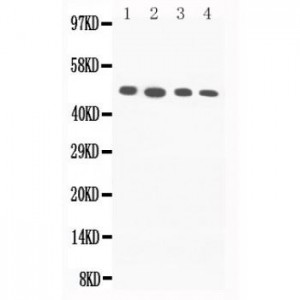More info
Overview
Long Name | Antibody Type | Antibody Isotype | Host | Species Reactivity | Validated Applications | Purification |
| SMAD family member 2/3 | Polyclonal | IgG | Rabbit | Human, Mouse, Rat | WB | Immunogen affinity purified. |
Immunogen | ||||||
| A synthetic peptide corresponding to a sequence at the C-terminus of human SMAD2/3(358-374 QSPNCNQRYGWHPATVC), identical to the related mouse and rat sequences. | ||||||
Properties
Form | Lyophilized |
Size | 100 µg/vial |
Contents | Antibody is lyophilized with 5 mg BSA, 0.9 mg NaCl, 0.2 mg Na2HPO4, 0.05 mg Thimerosal and 0.05 mg NaN3. *carrier free antibody available upon request. |
Concentration | Reconstitute with 0.2 mL sterile dH2O (500 µg/ml final concentration). |
Storage | At -20 °C for 12 months, as supplied. Store reconstituted antibody at 2-8 °C for one month. For long-term storage, aliquot and store at -20 °C. Avoid repeated freezing and thawing. |
Additional Information Regarding the Antigen
Gene | SMAD2/3 |
Protein | Mothers against decapentaplegic homolog 2/3 |
Uniprot ID | Q15796 |
Function | Receptor-regulated SMAD (R-SMAD) that is an intracellular signal transducer and transcriptional modulator activated by TGF-beta (transforming growth factor) and activin type 1 receptor kinases. Binds the TRE element in the promoter region of many genes that are regulated by TGF-beta and, on formation of the SMAD2/SMAD4 complex, activates transcription. May act as a tumor suppressor in colorectal carcinoma. Positively regulates PDPK1 kinase activity by stimulating its dissociation from the 14-3-3 protein YWHAQ which acts as a negative regulator. |
Tissue Specificity | Expressed at high levels in skeletal muscle, endothelial cells, heart and placenta. |
Sub-cellular localization | Cytoplasm. Nucleus. Note: Cytoplasmic and nuclear in the absence of TGF-beta. On TGF-beta stimulation, migrates to the nucleus when complexed with SMAD4. On dephosphorylation by phosphatase PPM1A, released from the SMAD2/SMAD4 complex, and exported out of the nucleus by interaction with RANBP1. |
Sequence Similarities | Belongs to the dwarfin/SMAD family. |
Aliases |
Application Details
| Application | Concentration* | Species | Validated Using** |
| Western blot | 0.1-0.5μg/ml | Human Mouse, Rat | AssaySolutio's ECL kit |
AssaySolution recommends Rabbit Chemiluminescent WB Detection Kit (AKIT001B) for Western blot. *Blocking peptide can be purchased at $65. Contact us for more information

All lanes: Anti-SMAD2/3(ASA-B1727) at 0.5ug/ml
Lane 1: SMMC Whole Cell Lysate at 40ug
Lane 2: U87 Whole Cell Lysate at 40ug
Lane 3: HELA Whole Cell Lysate at 40ug
Lane 4: MCF-7 Whole Cell Lysate at 40ug
Predicted bind size: 48KD
Observed bind size: 48KD
Lane 1: SMMC Whole Cell Lysate at 40ug
Lane 2: U87 Whole Cell Lysate at 40ug
Lane 3: HELA Whole Cell Lysate at 40ug
Lane 4: MCF-7 Whole Cell Lysate at 40ug
Predicted bind size: 48KD
Observed bind size: 48KD



